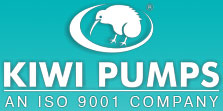
Pumps Information » Hydraulic Pumps
Hydraulic Pumps
Hydraulic Pumps deliver high-pressure fluid flow to the pump outlet. Hydraulic pumps are powered by mechanical energy sources to pressurize fluid. A hydraulic pump, when powered by pressurized fluid, can rotate in a reverse direction and act as a motor. Operating specifications, housing materials, and features are all important specifications to consider when searching for hydraulic pumps. Pump type and pump stages are the most important operating specifications to consider when searching for hydraulic pumps. Choices for hydraulic pumps types include axial piston, radial piston, internal gear, external gear, and vane. An axial piston pump uses an axially-mounted piston to pressurize fluid. Mechanical motion from the pumps power source moves the piston through a chamber, pressurizing the fluid it comes in contact with.
A radial piston pump uses pistons mounted radially about a central axis to pressurize fluid. An alternate-form radial piston motor uses multiple interconnected pistons, usually in a star pattern. The hydraulic pumps power source causes the pistons to move, forcing the pistons through the chambers and pressurizing fluid. An internal gear pump uses internal gears to pressurize fluid. The pumps power source causes the internal gears to turn, which forces fluid through the pump outlet. An external gear pump uses external gears to pressurize fluid. The pumps power source causes external gears to turn, which forces fluid through the pump outlet. A vane pump uses a vane to pressurize fluid. The pumps power source causes the vane to rotate. As the vane rotates, blades on the vane push fluid out the pumps outlet.
Pump stages include single stage, double stage, triple stage, and four or more pump stages.Additional operating specifications to consider for hydraulic pumps include continuous operating pressure, maximum operating pressure, operating speed, operating horsepower, operating temperature, maximum fluid flow, maximum fluid viscosity, displacement per revolution, and pump weight. The continuous operating pressure is the maximum pressure available at the pump outlet. The maximum operating pressure refers to the maximum peak pressure available at the pump outlet on a noncontiguous (intermittent) basis. The operating speed is the speed at which the pumps moving parts rotate is expressed in revolutions per minute, or similar terms.
The operating horsepower is the amount of power the pump is capable of delivering. Horsepower is dependent on the pressure and flow of the fluid through the pump. The operating temperature is the fluid temperature range the pump can accommodate. Maximum and minimum fluid temperature is dependent upon internal component materials, and varies greatly between manufacturers. The maximum volumetric flow through the pump is expressed in terms of gallons per minute, or similar units. The maximum fluid viscosity the hydraulic pump can accommodate is a measure of the fluids resistance to shear, and is measured in centipoise. Centipoise is a common metric unit of dynamic viscosity equal to 0.01 poise or 1 millipascal second.
The dynamic viscosity of water at 20 degrees C is about 1 centipoise. The correct unit is cP, but cPs and cPo are sometimes used. The fluid volume displaced per revolution of the pump is measured in cubic centimeters (cc) per revolution, or similar units. The weight of the hydraulic pump is measured in pounds or similar units.
